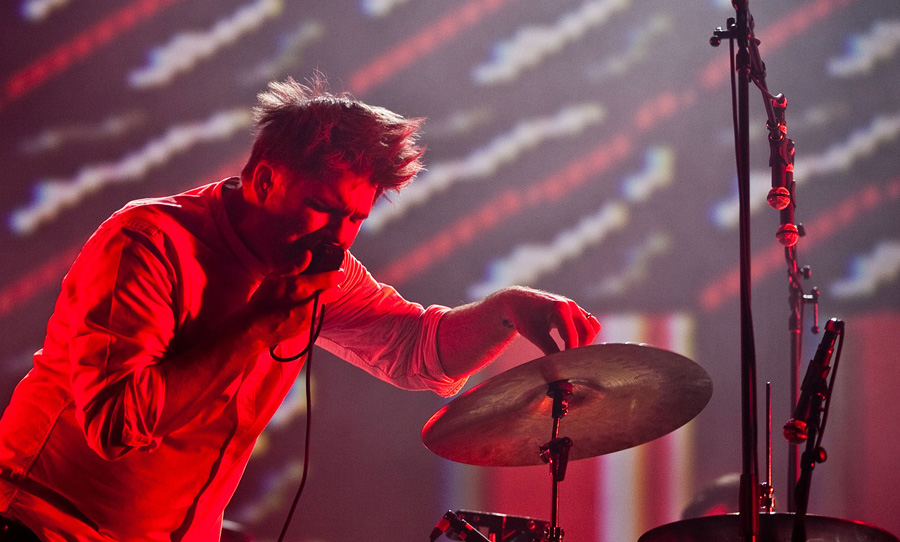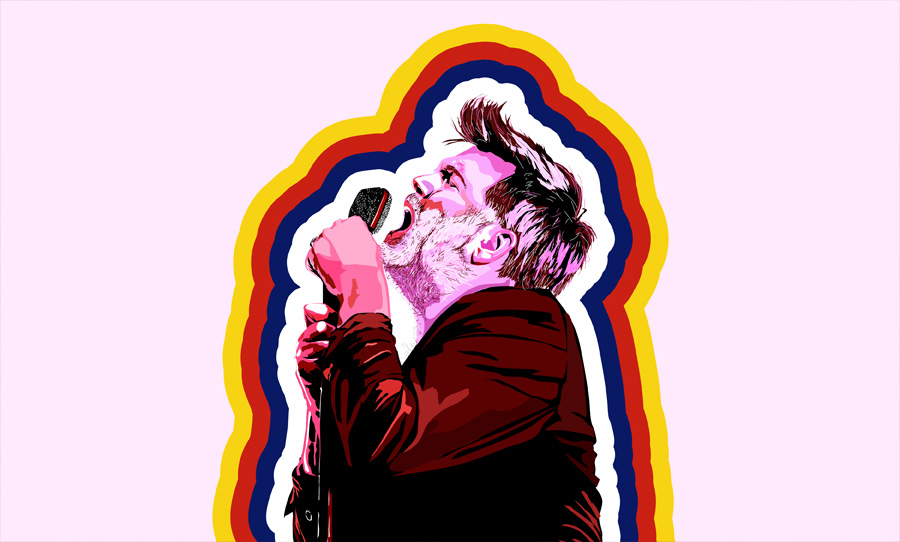It’s been a decade since LCD Soundsystem’s ‘Long Goodbye’ concert at Madison Square Garden, and we’re looking back on it as the best breakup show ever performed.
It’s strange to think that in 2021, what was essentially one of the largest indie-rock/ electro-pop acts of all time, namely LCD Soundsystem, has been reduced to a passing conversation piece amongst online music aficionados, and a side note when addressing the soundtrack of the naughts.
LCD Soundsystem was once one of the most iconic indie outfits on the planet, their bittersweet pop tunes being just as tear-jerking as they were danceable. The very fact that they fell so far back from the current musical zeitgeist can possibly be attributed to the climactic explosion of love and mourning that was their final show: the ‘Long Goodbye’ concert at Madison Square Garden.

LCD began as a mostly live performance band in 2002 fronted by James Murphy — a 31-year-old music fan who was looking to finally cash in on all the years spent participating in the scene from the shadows. Having been the co-founder of Brooklyn record label Death From Above, and after DJing his fair share of parties throughout New York, he decided that there was nothing stopping him from throwing his hat into the ring and cranking out his own tunes.
He tackled this with songs that drew heavy inspiration from ’80s new wave, whilst blending in the contemporary electronica and dance aesthetic of mid-2000s America. It was the anthemic and dancefloor-friendly sounds of Talking Heads, The B-52’s, The Fall, and David Bowie — but updated for the party-going kids of 2006 — and it blew them the fuck up.
Songs like Daft Punk is Playing At My House, and Losing My Edge are these sardonic and curmudgeonly tongue-in-cheek bops, which serve a dual purpose of critiquing the drunk scenester kids who were likely dancing along at their shows. But they didn’t give them any reason not to.
Murphy weaves incredibly infectious electronic-infused drum grooves with drawn-out, euphorically crescendoing cadences to make some of the most easily danceable songs of the time — but not without a strong self-aware sense of irony. And this same self-awareness would be the thing that ultimately inspired this ‘final’ show.
Here’s the memorable announcement from the band’s website at the time:
good people of earth: lcd soundsystem are playing madison square garden on april 2nd, and it will be our last show ever. we are retiring from the game. gettin’ out. movin’ on. but for just one more night, we will be playing with friends and family for nearly 3 hours–playing stuff we’ve never played before and going out with a bang. and we’d like you to be there.
After no more than nine years of performing, with three studio albums, an infamous Nike-commissioned EP, and a handful of singles under their belt, LCD Soundsystem decided to hang up the boots and head into early retirement, much to the dismay of the pantheon of fans they had amassed.
Over the near-decade they had been together, their records had charted in the top 10 spots while receiving high critical acclaim, earning them collaborations with filmmakers like Spike Jonze, and even seeing them headline international festivals. But Murphy had decided that the most interesting thing that the band could do — at the peak of its notoriety — was to stop.
This decision confused fans at the time, and still confuses fans to this day, but it is admittedly somewhat understandable. Not only was Murphy reaching his mid-’40s (an age that makes touring 12 cities in 14 days no cakewalk) but he had arrived at a point with his music where being a solo creative force was taking its toll.
At the end of the day, the whole direction and trajectory of LCD fell on Murphy’s shoulders alone, and since most of his time was taken up with all of the extraneous shit that comes alongside having such a successful project (touring, album rollouts, sourcing and directing the accompanying band, rehearsing and designing a live performance) — the writing itself had become a more arduous process than anything else.
From this, it isn’t too much of a stretch to imagine that a man with Murphy’s strong sense of self-awareness would recognise that continuing down this negative path would turn LCD into one of the washed-up music figures that Murphy himself had become accustomed to mocking. He didn’t want to be one of those artists who stick around way past their due date without anything new to say. And so it was decided: let’s send the band off with ‘the best funeral ever’ — and one of the greatest live performances of all time.
if you would, we’d love it if people all came in white. or black. or black and white. and come ready to have fun, please.
The audience was to be in a euphoric state of mourning, blending the lines between celebration and sadness in a way that perfectly reflected the mood of LCD’s music. 20,000 tickets sold out in 15 seconds, with people planning international trips just to see this gig, and fans even selling their belongings to afford the interstate flights to New York.
The journey to Madison Square Garden became a musical pilgrimage to some, and so the stakes were impossibly high for Murphy and the crew. But as he himself states 20 minutes into the set after introducing each of the band members: “I hope you know that this isn’t going to get any more professional.”
They weren’t there to do anything other than Shut Up and Play the Hits. And that’s what they did.
The set was just over three-hours long: 28 songs covering the wide scope of LCD Soundsystem’s 9-year career, with some of the most palpable crowd atmosphere ever recorded. I’m not kidding, if you listen to the live recordings that the band released on Record Store Day three years after the gig (and linked on Spotify just above), there’s a rapturous energy and frantic euphoria present in the room. It’s all wondrously translated in these recordings.
You can clearly tell that the audience was here to celebrate one of the most evocative acts of the 2000s for the last time, and it’s not surprising when they lose their fucking shit after hearing the opening synth hits and “oh-aaahs” of Dance Yrself Clean. All My Friends gets a similar reaction, with the crowd finding the answer amongst one another when Murphy asks “Where are your friends tonight?”.
The second third of the gig sees Murphy taking a note from David Byrne’s playbook, and bringing almost as many people as he could fit onto the stage. There’s a brass section (with a younger Colin Stetson on Bass Sax), a 45:33 jam featuring Reggie Watts on vocals, a vocoder, an entire choir, and a guest appearance from Arcade Fire on North American Scum. This really was an all-in show, and it bloody well popped off. It’s no surprise that Anne Hathaway described the show as 2011’s Woodstock.
As the show slowly came to a close, it reached the emotional heights that LCD are known for. In fact, I don’t think I’ve ever related more to anyone than the kid in the audience bawling his eyes out whilst screaming along to the “oh-aahs” on Home (6:44 in the above video).
The show finished with a fantastically noisy cover of Harry Nilsson’s Jump into the Fire, a surprise Twin Peaks cover, and wrapped up the only way an LCD show can — with New York I Love You, But You’re Bringing Me Down. Murphy himself seems to find it difficult to hold back tears on this one, having finally come full circle, airing his (still surprisingly relevant) grievances to the city in its most iconic concert space for the last time, in front of a congregation of fans who don’t yet seem ready to move on. And just like that, balloons fall from the ceiling, the band walks off stage and LCD is done.
For a couple of years.
LCD would later get back together to release a new record that reached middling critical success but sold enough to allow them to tour internationally with a couple of familiar faces in the backing band — but it was never to the acclaim that they reached in their prime.
In the sardonic tone we’ve come to expect of Murphy, he’s since said that the band’s only reason for announcing the breakup show was to sell more tickets, but regardless of just how much of a self-aware piss-take this is, he was definitely right about one thing. The most interesting thing that LCD could’ve done in 2011 was break up. If nothing else it led to one of the greatest live performances of all time — the ultimate emotional miasma of mourning and celebration — and one which will likely be never repeated.



